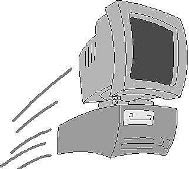 So, you got yourself a new computer, but its not shaping up to what it used to be all that time ago? Here’s how you can help speed up your computer to like it used to be. All changes you make is at your own risk, no responsibility is taken if your computer stops working
So, you got yourself a new computer, but its not shaping up to what it used to be all that time ago? Here’s how you can help speed up your computer to like it used to be. All changes you make is at your own risk, no responsibility is taken if your computer stops workingStep 1: Opening the system configuration
This tool allows you to edit your windows start-up configuration changing what will run and what will not. Open the utility by going to Start, and then Run. Afterwards, type in “msconfig” and press OK. In Windows Vista, you may have to type ‘run’ into the search box on Start. Users with Windows 2000 do not have this utility, but they can still use it by copying the file from Windows XP or Vista and putting it onto your system. Operating systems below 2000 can not run this utility.
Step 2: Editing the startup settings
By clicking the ‘Startup’ tab, you can now choose what processes you would like to run on your computer at start-up. The more you uncheck, the faster your computer will be. Obviously, do not uncheck any Microsoft or Windows Operating System processes, as these will stop your computer from working. Make sure you leave checked any processes required for sound, video, display and virus protection software. It is inadvisable that you change any other setting, but once finished, restart your computer.
Step 3: Uninstalling unnecessary programs
After time you may have got yourself programs you don’t even need anymore. You can easily uninstall these programs from your Control Panel. Going to your Control Panel and selecting ‘Add or Remove Programs’, or for Vista users ‘Programs and Features’, will bring up the necessary screen. Browse through the list of programs you have, and choose the uninstall tab on the program you wish to remove, highlighting first the program you want to remove. Once the setup is done, continue uninstalling programs until you are happy, it also will free up extra space on your hard drive. Restart the computer once finished. Do not uninstall any programs that have been installed by Windows Update / Microsoft Update, these are necessary to keep the computer working properly. Also, do not uninstall Java.
Step 4: Running a disk defragmenter
Defragmenting your hard disk helps to speed up your computer and its ability to load files faster. To run this, go to Start, then All Programs, then Accessories, then System Tools, and finally choose Disk Defragmenter. It may take several hours to complete, but it can be worth the time after.
Step 5: Adjusting your computer for best performance
If you like the style of the old Windows Classic themes, you should follow this step to enable your computer to be faster. Sure it’ll look a bit uglier on the eyes, but at least you’ll be ahead of the game. Going to Control Panel, then System (then Advanced System settings for Vista), will bring up your computer’s system information. Click the advanced tab, if not already, and press the ‘Settings’ button underneath performance. Select the option to “Adjust for best performance” and press apply.
Step 6: Increasing the virtual memory
Virtual memory, also known as Page File memory, uses a portion of your hard disk and acts like RAM allowing more information to be used and made at one time. It stores data about programs while your computer is running, and dumps it as needs be. Keeping the performance window open, go to the Advanced tab. By clicking the ‘Change’ button will allow you to increase your virtual memory. Uncheck the setting “Automatically manage page filing size for all drives”. Then choose your hard disk drive from the list and choose custom size. Set the sizes accordingly to however much page file your computer uses (1024MB is best as an initial size). Once finished, press ‘Set’ and ‘OK’. You should not set your maximum size larger than double the minimum setting, otherwise too much space may be used on your hard drive leaving you nothing left.
Step 7: Running a virus scan
If you have an anti-virus scanner installer on your computer, have a disk with one on handy, or a place to get a free scanner (Such as Avast or AVG free), run a thorough virus scan on your computer, it will help to detect any harmful computer viruses and remove or contain them in a secure way. Viruses will slow down you computer, so it is handy to have.